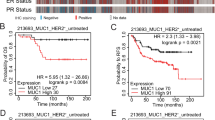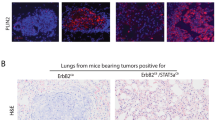Abstract
Upregulation of HER2/ErbB2/Neu occurs in 15–30% of human breast cancers and correlates with poor prognosis. Identification of ErbB2/Neu transcriptional targets should facilitate development of novel therapeutic approaches. Development of breast cancer is a multistep process; thus, to identify the transcriptomes associated with different stages of progression of tumorigenesis, we compared expression profiles of mammary tumors and preneoplastic mammary tissue from MMTV-Neu transgenic mice to expression profiles of wild-type mammary glands using Affymetrix microarrays. We identified 324 candidate genes that were unique to ErbB2/Neu-induced tumors relative to normal mammary gland tissue from wild-type controls. Expression of a subset of these genes (82) was also changed in the preneoplastic mammary glands compared to wild-type controls, indicating that they may play a pivotal role during early events of ErbB2/Neu-initiated mammary tumorigenesis. Further analysis of the microarray data revealed that expression of several known transforming growth factor (TGF)-β target genes was altered, suggesting that the TGF-β signaling cascade is downregulated in ErbB2/Neu-induced tumors. Western blot analysis for TGF-β-Receptor-I/ALK5 and immunohistochemistry for TGF-β-Receptor-I/ALK5 and phosphorylated/activated Smad2 confirmed that the Smad-dependent TGF-β signaling cascade was inactive in these tumors. Although absent in most of the tumor, phosphorylated Smad2 was present in the periphery of tumors. Interestingly, presence of phosphorylated/activated Smad2 correlated with expression of Activin-Receptor-IB/ALK4, suggesting that although Smad-dependent TGF-β signaling is absent in ErbB2/Neu-induced tumors, Activin signaling may be active at the leading edge of these tumors. Cumulatively, these data indicate that the TGF-β pathway is intrinsically suppressed in ErbB2/Neu tumors via a mechanism involving loss of TGF-β-Receptor-I/ALK5.
This is a preview of subscription content, access via your institution
Access options
Subscribe to this journal
Receive 50 print issues and online access
$259.00 per year
only $5.18 per issue
Buy this article
- Purchase on Springer Link
- Instant access to full article PDF
Prices may be subject to local taxes which are calculated during checkout








Similar content being viewed by others
References
Alroy I and Yarden Y . (1997). FEBS Lett., 410, 83–86.
Andrechek ER, Laing MA, Girgis-Gabardo AA, Siegel PM, Cardiff RD and Muller WJ . (2003). Cancer Res., 63, 4920–4926.
Barcellos-Hoff MH and Ewan KB . (2000). Breast Cancer Res., 2, 92–99.
Bertucci F, Borie N, Ginestier C, Groulet A, Charafe-Jauffret E, Adelaide J, Geneix J, Bachelart L, Finetti P, Koki A, Hermitte F, Hassoun J, Debono S, Viens P, Fert V, Jacquemier J and Birnbaum D . (2004). Oncogene, 23, 2564–2575.
Boggio K, Nicoletti G, Di Carlo E, Cavallo F, Landuzzi L, Melani C, Giovarelli M, Rossi I, Nanni P, De Giovanni C, Bouchard P, Wolf S, Modesti A, Musiani P, Lollini PL, Colombo MP and Forni G . (1998). J. Exp. Med., 188, 589–596.
Bouchard L, Lamarre L, Tremblay PJ and Jolicoeur P . (1989). Cell, 57, 931–936.
Brazma A, Hingamp P, Quackenbush J, Sherlock G, Spellman P, Stoeckert C, Aach J, Ansorge W, Ball CA, Causton HC, Gaasterland T, Glenisson P, Holstege FC, Kim IF, Markowitz V, Matese JC, Parkinson H, Robinson A, Sarkans U, Schulze-Kremer S, Stewart J, Taylor R, Vilo J and Vingron M . (2001). Nat. Genet., 29, 365–371.
Bulavin DV, Phillips C, Nannenga B, Timofeev O, Donehower LA, Anderson CW, Appella E and Fornace Jr AJ . (2004). Nat. Genet., 36, 343–350.
Chambers RC, Leoni P, Kaminski N, Laurent GJ and Heller RA . (2003). Am. J. Pathol., 162, 533–546.
Derynck R, Akhurst RJ and Balmain A . (2001). Nat. Genet., 29, 117–129.
Desai KV, Xiao N, Wang W, Gangi L, Greene J, Powell JI, Dickson R, Furth P, Hunter K, Kucherlapati R, Simon R, Liu ET and Green JE . (2002). Proc. Natl. Acad. Sci. USA, 99, 6967.
Dowdy SC, Mariani A and Janknecht R . (2003). J. Biol. Chem., 278, 44377–44384.
Dressman MA, Baras A, Malinowski R, Alvis LB, Kwon I, Walz TM and Polymeropoulos MH . (2003). Cancer Res., 63, 2194.
Eisen MB, Spellman PT, Brown PO and Botstein D . (1998). Proc. Natl. Acad. Sci. USA, 95, 14863–14868.
Graus-Porta D, Beerli RR, Daly JM and Hynes NE . (1997). EMBO J., 16, 1647–1655.
Guy CT, Cardiff RD and Muller WJ . (1996). J. Biol. Chem., 271, 7673–7678.
Guy CT, Webster MA, Schaller M, Parsons TJ, Cardiff RD and Muller WJ . (1992). Proc. Natl. Acad. Sci. USA, 89, 10578–10582.
Holbro T, Civenni G and Hynes NE . (2003). Exp. Cell Res., 284, 99–110.
Hynes NE and Stern DF . (1994). Biochim. Biophys. Acta, 1198, 165–184.
Jacquemier J, Ginestier C, Rougemont J, Bardou VJ, Charafe-Jauffret E, Geneix J, Adelaide J, Koki A, Houvenaeghel G, Hassoun J, Maraninchi D, Viens P, Birnbaum D and Bertucci F . (2005). Cancer Res., 65, 767–779.
Kauraniemi P, Barlund M, Monni O and Kallioniemi A . (2001). Cancer Res., 61, 8235–8240.
Kauraniemi P, Hautaniemi S, Autio R, Astola J, Monni O, Elkahloun A and Kallioniemi A . (2004). Oncogene, 23, 1010–1013.
Krishnamurthy S and Sneige N . (2002). Adv. Anat. Pathol., 9, 185–197.
Kumar-Sinha C, Ignatoski KW, Lippman ME, Ethier SP and Chinnaiyan AM . (2003). Cancer Res., 63, 132–139.
Lee RJ, Albanese C, Fu M, D’Amico M, Lin B, Watanabe G, Haines GK, Siegel PM, Hung MC, Yarden Y, Horowitz JM, Muller WJ and Pestell RG . (2000). Mol. Cell. Biol., 20, 672–683.
Lenferink AE, Simpson JF, Shawver LK, Coffey RJ, Forbes JT and Arteaga CL . (2000). Proc. Natl. Acad. Sci. USA, 97, 9609–9614.
Li B, Rosen JM, McMenamin-Balano J, Muller WJ and Perkins AS . (1997). Mol. Cell. Biol., 17, 3155–3163.
Mackay A, Jones C, Dexter T, Silva RL, Bulmer K, Jones A, Simpson P, Harris RA, Jat PS, Neville AM, Reis LF, Lakhani SR and O’Hare MJ . (2003). Oncogene, 22, 2680–2688.
Massague J . (1998). Annu. Rev. Biochem., 67, 753–791.
Milliken EL, Ameduri RK, Landis MD, Behrooz A, Abdul-Karim FW and Keri RA . (2002). Endocrinology, 143, 3671–3680.
Morrison BW and Leder P . (1994). Oncogene, 9, 3417–3426.
Muller WJ, Sinn E, Pattengale PK, Wallace R and Leder P . (1988). Cell, 54, 105–115.
Muraoka RS, Koh Y, Roebuck LR, Sanders ME, Brantley-Sieders D, Gorska AE, Moses HL and Arteaga CL . (2003). Mol. Cell. Biol., 23, 8691–8703.
Perou CM, Sorlie T, Eisen MB, van de RM, Jeffrey SS, Rees CA, Pollack JR, Ross DT, Johnsen H, Akslen LA, Fluge O, Pergamenschikov A, Williams C, Zhu SX, Lonning PE, Borresen-Dale AL, Brown PO and Botstein D . (2000). Nature, 406, 747–752.
Pimentel RC, Yamada KA, Kleber AG and Saffitz JE . (2002). Circ. Res., 90, 671–677.
Ramaswamy S, Ross KN, Lander ES and Golub TR . (2003). Nat. Genet., 33, 49–54.
Reiss M . (1999). Microbes Infect., 1, 1327–1347.
Roberts AB and Wakefield LM . (2003). Proc. Natl. Acad. Sci. USA, 100, 8621–8623.
Salomon DS, Brandt R, Ciardiello F and Normanno N . (1995). Crit. Rev. Oncol. Hematol., 19, 183–232.
Shepherd TG, Kockeritz L, Szrajber MR, Muller WJ and Hassell JA . (2001). Curr. Biol., 11, 1739–1748.
Siegel PM, Dankort DL, Hardy WR and Muller WJ . (1994). Mol. Cell. Biol., 14, 7068–7077.
Siegel PM, Shu W, Cardiff RD, Muller WJ and Massague J . (2003). Proc. Natl. Acad. Sci. USA, 100, 8430–8435.
Slamon DJ, Godolphin W, Jones LA, Holt JA, Wong SG, Keith DE, Levin WJ, Stuart SG, Udove J, Ullrich A and Press MF . (1989). Science, 244, 707–712.
Tamayo P, Slonim D, Mesirov J, Zhu Q, Kitareewan S, Dmitrovsky E, Lander ES and Golub TR . (1999). Proc. Natl. Acad. Sci. USA, 96, 2907–2912.
Tang B, Vu M, Booker T, Santner SJ, Miller FR, Anver MR and Wakefield LM . (2003). J. Clin. Invest., 112, 1116–1124.
Tzahar E, Waterman H, Chen X, Levkowitz G, Karunagaran D, Lavi S, Ratzkin BJ and Yarden Y . (1996). Mol. Cell. Biol., 16, 5276–5287.
Verrecchia F, Chu ML and Mauviel A . (2001). J Biol. Chem., 276, 17058–17062.
Wakefield LM, Yang YA and Dukhanina O . (2000). Breast Cancer Res., 2, 100–106.
Wang N, Kudryavtseva E, Ch'en IL, McCormick J, Sugihara TM, Ruiz R and Andersen B . (2004). Oncogene, 23, 1507–1513.
Wellings SR and Jensen HM . (1973). J. Natl. Cancer Inst., 50, 1111–1118.
Wilson KS, Roberts H, Leek R, Harris AL and Geradts J . (2002). Am. J. Pathol., 161, 1171.
Wright C, Nicholson S, Angus B, Sainsbury JR, Farndon J, Cairns J, Harris AL and Horne CH . (1992). Br. J. Cancer, 65, 118–121.
Yamamoto T, Ikawa S, Akiyama T, Semba K, Nomura N, Miyajima N, Saito T and Toyoshima K . (1986). Nature, 319, 230–234.
Yang Y, Dukhanina O, Tang B, Mamura M, Letterio JJ, MacGregor J, Patel SC, Khozin S, Liu Z, Green J, Anver MR, Merlino G and Wakefield LM . (2002). J. Clin. Invest., 109, 1607–1615.
Yu Q, Geng Y and Sicinski P . (2001). Nature, 411, 1017–1021.
Yue J and Mulder KM . (2001). Pharmacol. Ther., 91, 1–34.
Acknowledgements
We extend special thanks to Kristen Lozada for her dedicated technical support and Erin Milliken for intellectual discussions. Tumor histology was performed by the Histology Core Facility of the CASE Comprehensive Cancer Center. Microarray work was supported by the Gene Expression Array Core Facility of the CASE Comprehensive Cancer Center (P30CA43703). RAK was supported by National Institutes of Health Grant (RO1-CA90398). MDL was supported by a Breast Cancer Research Program (BCRP) Predoctoral Traineeship Award (DAMD17-03-1-0302) and the National Institutes of Health Molecular Therapeutics Training Program (GM08803A1).
Author information
Authors and Affiliations
Corresponding author
Additional information
Supplementary Information accompanies the paper on the Oncogene website (http://www.nature.com/onc)
Supplementary information
Rights and permissions
About this article
Cite this article
Landis, M., Seachrist, D., Montañez-Wiscovich, M. et al. Gene expression profiling of cancer progression reveals intrinsic regulation of transforming growth factor-β signaling in ErbB2/Neu-induced tumors from transgenic mice. Oncogene 24, 5173–5190 (2005). https://doi.org/10.1038/sj.onc.1208712
Received:
Revised:
Accepted:
Published:
Issue Date:
DOI: https://doi.org/10.1038/sj.onc.1208712
Keywords
This article is cited by
-
The diversity and breadth of cancer cell fatty acid metabolism
Cancer & Metabolism (2021)
-
Testes-specific protease 50 promotes cell proliferation via inhibiting activin signaling
Oncogene (2017)
-
Identification of Mouse MARVELD1 as a Microtubule Associated Protein that Inhibits Cell Cycle Progression and Migration
Molecules and Cells (2011)
-
The predictive value of genes of the TGF-β1 pathway in multimodally treated squamous cell carcinoma of the esophagus
International Journal of Colorectal Disease (2010)
-
LMO4 is an essential mediator of ErbB2/HER2/Neu-induced breast cancer cell cycle progression
Oncogene (2009)



